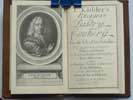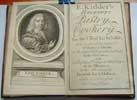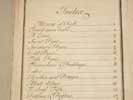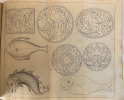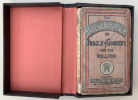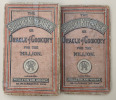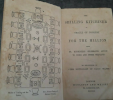A Choice Manual, or rare secrets in physick and chirugery;
Collected, & practised by the Right Honourable the Countess of Kent, Late deceased. Whereto are added several Experiments of the vertue of Gascons powder, and Lapis contra Yarvam by a Professor of Physick. As also most exquisite ways of Preserving, Conserving, Candying, etc. The Nineteenth Edition. London, Printed for H. Mortlock at the Phoenix in St. Pauls Churchyard. 1687. WITH A SECOND PART: A True Gentlewomans DELIGHT. Wherein is contain'd all manner of COOKERY. Together with: Preserving, Conserving, Drying, and Candying. Very necessary for all Ladies and Gentlewomen. Published by W.G. Gent. LONDON, Printed for Henry Mortlock, at the Phoenix in St. Paul's Churchyard, 1687.
Small 12mo. Portrait frontispiece. (it has been bound in on the recto instead of the usual verso) Title page. 2pp Epistle by W.J. 2pp 'To the Reader' 10pp 'Contents' (1-234) THE 2ND PART: Separate pagination - 6pp 'Table of Contents' Title page. 2pp Epistle by W.J. 2pp 'To the Reader' 14pp 'Contents' (1-140) Contemporary black goatskin boards re-laid, surface quite worn but with a nice patina. Dark calf, blind ruled spine re-laid, blind fillet border on sides, re-cased using old paper, new sewn headband, very sound. Internally very clean with mild overall aging.
- Elizabeth Grey, Countess of Kent, born December 7th 1582 - died 1651, née Lady Elizabeth Talbot, was the wife of Henry Grey, 8th Earl of Kent. She was a daughter of Gilbert Talbot, 7th Earl of Shrewsbury and Mary Cavendish. She married Grey on November 16, 1601, at St Martin's-in-the-Fields. They had no children, and the Earl died in 1639. Afterward she is thought to have married the writer, John Selden, who had worked for the Earl. After her death, her collection of medical recipes was published as 'A Choice Manual, or Rare Secrets in Physick and Chirurgery Collected and Practised by the Right Honourable the Countess of Kent, late deceased'. Her collection of cookery recipes were also added to the book as a second part. It was an interest she shared with her younger sister, Alethea Howard, Countess of Arundel. Sometimes, complete and separately bound copies of the 2nd part - 'A True Gentlewoman's Delight' are sold at auction, one such being offered at Bloomsbury Book Auctions in 2006. However complete copies like this one with both parts present are rare and much more desirable. This book, because of its small size (not much bigger than a miniature) and having the original cover, with the frontis of the Countess's rather crude but interesting portrait and the thick text block with under-developed remedies and recipes, has the ability to stop a person in their tracks. Keeping in mind the method now to digitally produce very glossy, high resolution, colourful cookery books, that on reflection, when held against this very old book, gives one a sharp sense of both that time and now, and the amazing changes to our world in those 323 intervening years. It also makes one ponder on how our endeavors will be viewed over 300 years from now; with the same sense of incredulous wonder I should imagine!




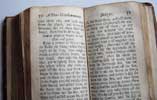
click on image to enlarge

Antiquarian category
ref number:
10933 












